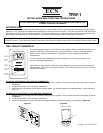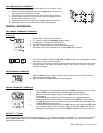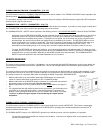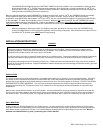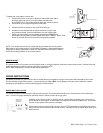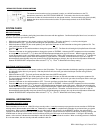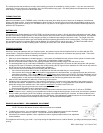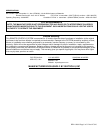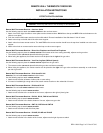
REV.1/25/05 Page 6 of 9 Part #17810
WIRING ELECTRONIC SPARK IGNITIONS
The remote control receiver can be connected, in series, to a 24VAC transformer to the TR
(transformer) terminal on the ELECTRONIC MODULE. Connect the hot wire from the 24VAC
transformer to either of the wire terminals on the remote receiver. Connect another wire (Not included)
between the other receiver wire terminal and the TH (thermostat) terminal on the ELECTRONIC
MODULE.
SYSTEM CHECK
MILLIVOLT VALVES
Light your gas appliance following the lighting instructions that came with the appliance. Confirm that the pilot flame is on; it must be in
operation for the main gas valve to operate.
• Slide the 3-position button on the remote receiver to the ON position. The main gas flame (i.e., the fire) should ignite.
• Slide the button to OFF. The flame should extinguish (the pilot flame will remain on).
• Slide the button to REMOTE (the center position), then press the ON
button on the transmitter to change the system to ON. The
main gas flame should ignite.
• Press the ON
button on the wall transmitter to change the system to OFF. The flame should extinguish (the pilot flame will remain
on).
• Press the ON
button on the wall transmitter to change the system to THERMO. Advance the SET temperature on the transmitter
to a temperature of a least 2
0
F (1
0
C) above the ROOM temperature displayed on the LCD screen. With this manual setting, the
normal thermostatic cycle is overridden and the system flame will ignite. Set the SET temperature to at least 2
0
F (1
0
C) below the
room temperature and the system flame will extinguish in a few seconds. Thereafter, it should continue to cycle to on and off
thermostatically approximately every two minutes as the ROOM temperature changes, but only when the temperature differential
between ROOM and SET temperatures differ at least 2
0
F (1
0
C). The 2
0
F differential is the factory setting.
ELECTRONIC IGNITION SYSTEMS
• Slide the 3-position button on the remote receiver to the ON position. The spark electrode should begin sparking to ignite the pilot
(the pilot may ignite after only one spark). After the pilot flame is lit, the main gas valve should open and the main gas flame
should ignite.
• Slide the button to OFF. The main gas flame and pilot flame should BOTH extinguish.
• Slide the button to REMOTE (the center position), then press the ON
button on the wall transmitter to change the system to ON.
The spark electrode should begin sparking to ignite the pilot. After the pilot is lit, the main gas valve should open and the main gas
flame should ignite.
• Press the ON
button on the wall transmitter to OFF. The main gas flame and pilot flame should BOTH extinguish.
• Press the ON
button on the wall transmitter to change the system to THERMO. Advance the SET temperature on the transmitter
to a temperature of at least 2
0
F (1
0
C) above the ROOM temperature displayed on the LCD screen. With this manual setting the
normal thermostatic cycle is overridden and the system flame will ignite. Set the SET temperature to at least 2
0
F (1
0
C) below the
room temperature and the system flame will extinguish in a few seconds. Thereafter, it should continue to cycle to on and off
thermostatically approximately every two minutes as the ROOM temperature changes, but only when the temperature differential
between ROOM and SET temperatures differ at least 2
0
F (1
0
C). (The 2
0
F differential is the factory setting).
GENERAL INFORMATION
MATCHING SECURITY CODES
Each transmitter can use one of 1,048,576 unique security codes. It may
be necessary to program the remote receiver to LEARN the
security code of the transmitter upon initial use
, if batteries are replaced, or if a replacement transmitter is purchased from your dealer
or the factory. When matching security codes, be sure slide button on the receiver is in the REMOTE position; the code will NOT
“LEARN” if the slide switch is in the ON or OFF position. Program the remote receiver to LEARN a new security code by pushing in the
LEARN button on the top of the remote receiver and then pressing the ON
button on the wall transmitter. A change in the beeping
pattern, at the receiver, indicates the transmitter’s code has been programmed into the receiver. When an existing receiver is matched
to a new transmitter, the new security code will override the old one.



